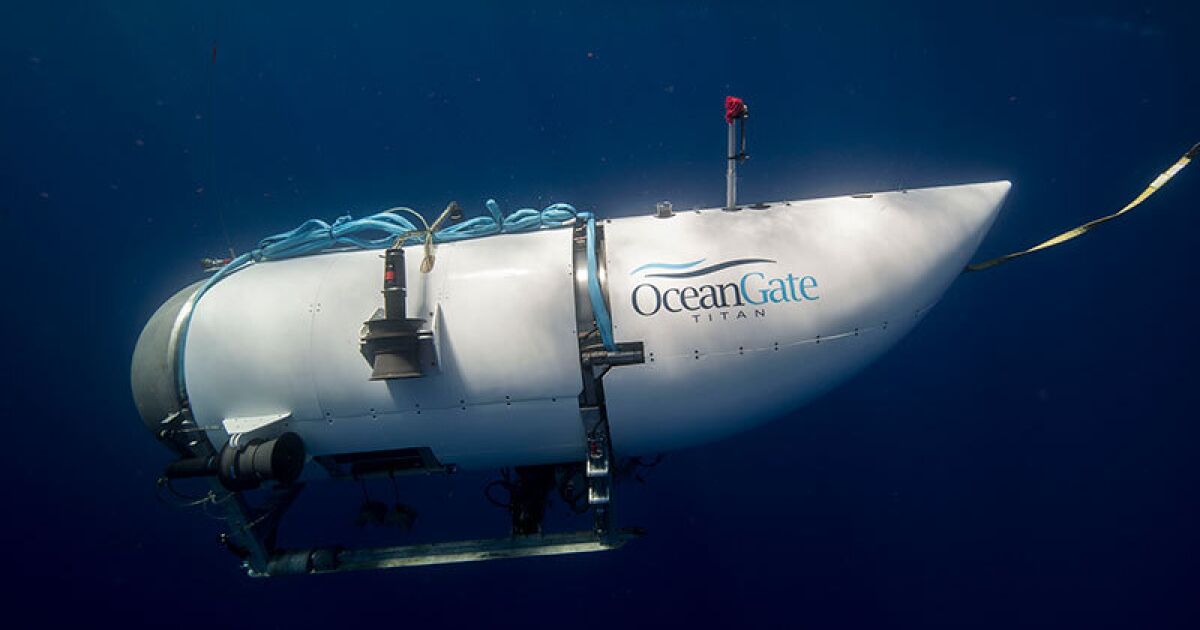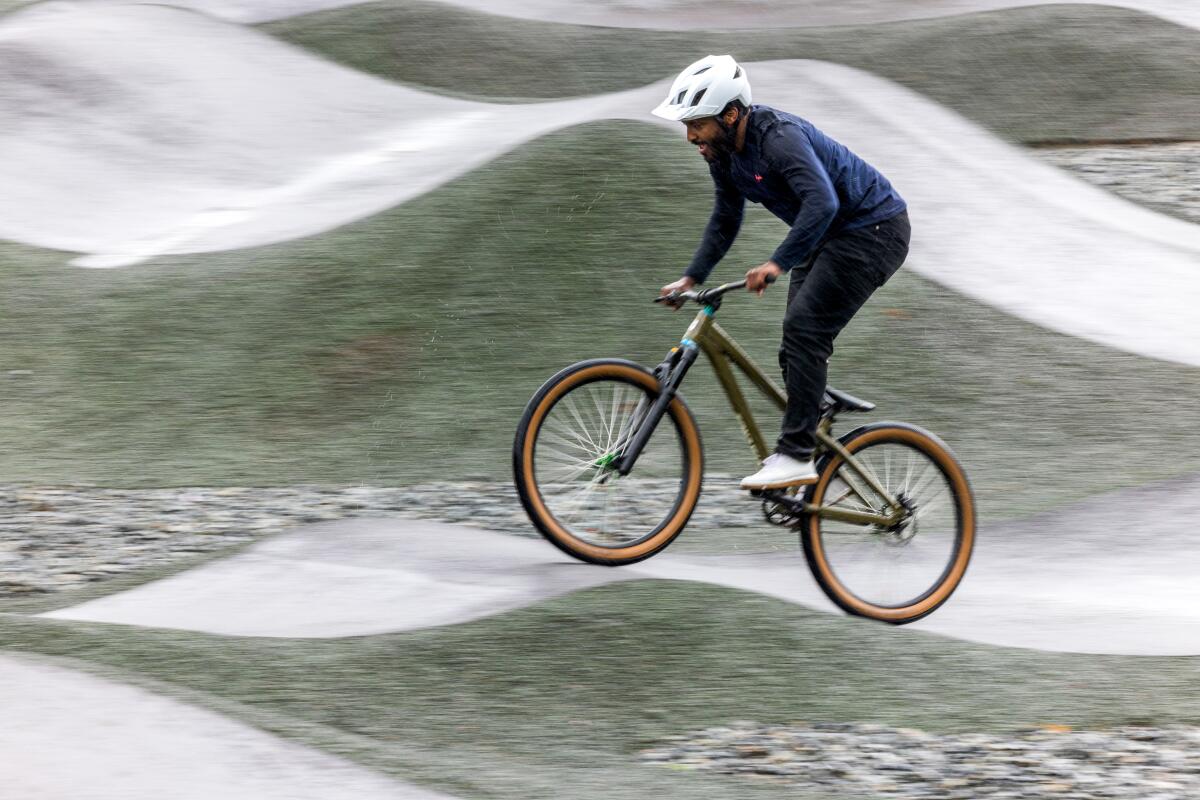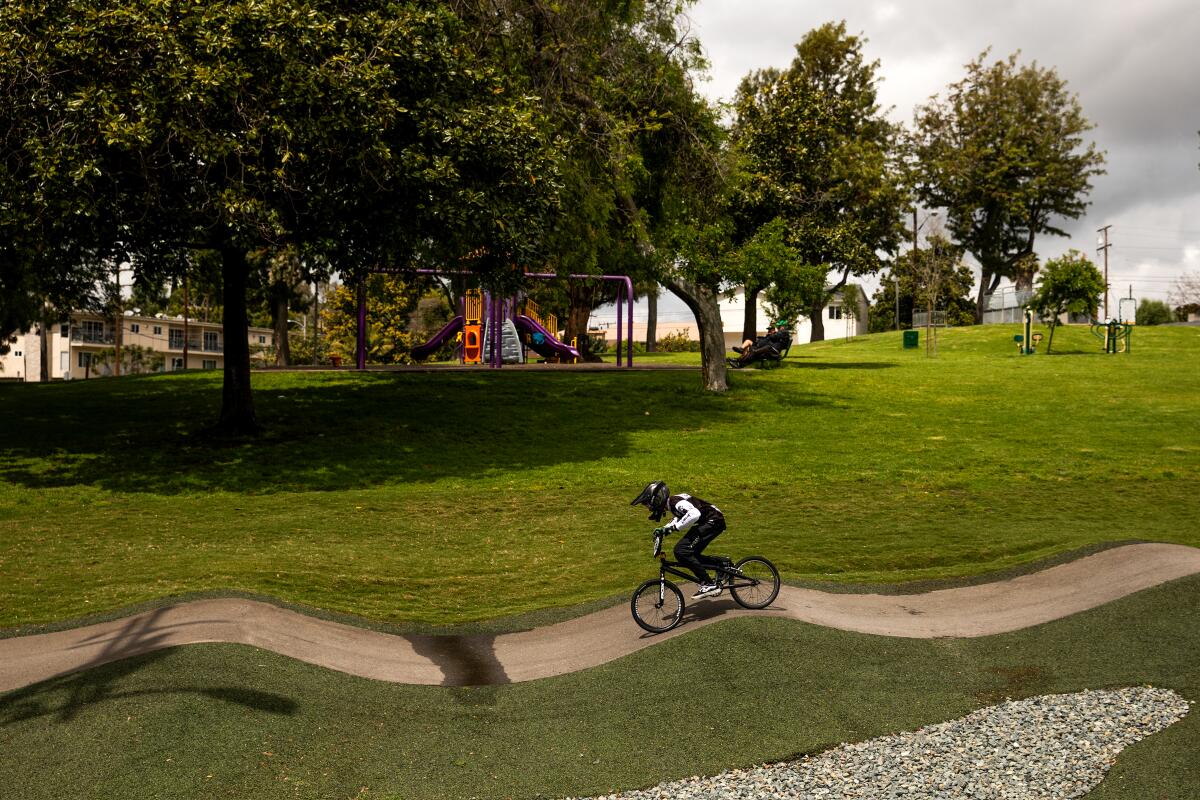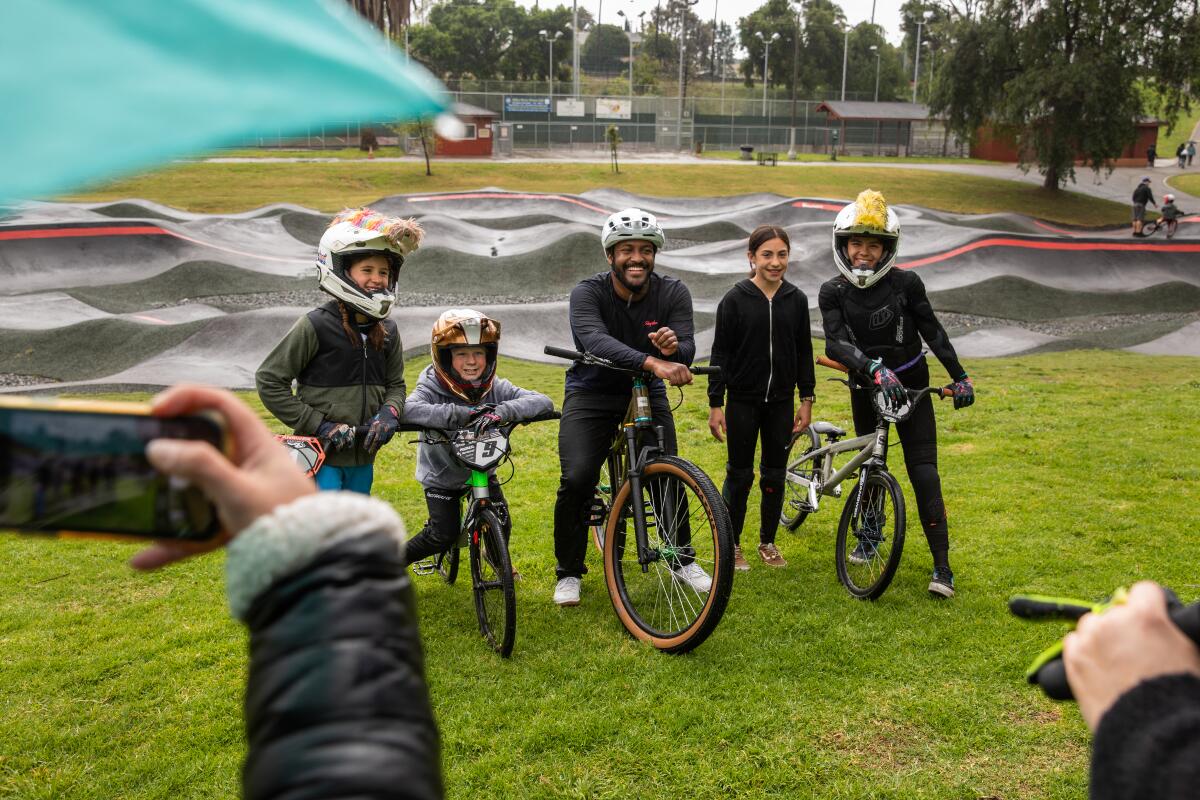Lifestyle
Should you chase the thrill? After Titan, adventurers weigh the risks of extreme travel

Where is your line? On your mental chart of risk and reward, where does yes become nope?
The Titan implosion on the sea floor off Newfoundland last week has many of us considering that question.
For the disaster’s five victims, it seems the prospect of exploring the Titanic wreckage was too tempting to pass up. Yet many otherwise bold travelers wouldn’t have dared climb into the vessel, even if the ride were free.
As a society, “We live in more comfort than we ever have, and we face fewer risks than we ever have. As that general decrease of risk has happened, our tolerance for it has seemed to decrease,” Sivani Babu told me recently.
Babu, who stepped away from her career in law to become a Santa Barbara-based photographer, writer and co-founder of the travel website hiddencompass.net, recently turned down a chance to go trekking in Nepal at 17,000 feet. When a friend arranged to cycle Bolivia’s notorious “Death Road” in Bolivia, Babu was not tempted.
Yet she has been storm-chasing for years. And Babu has visited Antarctica more than once by sailboat, lurching across heaving, frigid seas for a chance to photograph epic slabs of ice.
“When I take risks, I learn not just about myself but about the world around me,” she said. “Exploration for me and for Hidden Compass is not about conquering or being the first to do something. It’s about learning about ourselves and the world. And the reward that comes with that is huge.”
The more we think about the unnecessary physical risks we take in life — the off-duty moments we spend on mountains, on water, snow, sand and city streets, in the company of imperfect machinery and people — the less we agree.
Drawing on our own histories and assumptions, we all think and feel differently about what risks are worth the rewards. Perhaps, if you’re making decisions on behalf of loved ones — say, you’re a parent of young children — you become more conservative. Some studies point to the influence other people have on our decisions. Other research suggests that risk-taking behavior may be partially genetic. One way or another, it seems clear that feeling often overwhelms thinking.
Michael Shapiro taking a raft through the Grand Canyon in 2016.
(Jacqueline Yau)
I’ve watched fellow travelers make all sorts of choices.
Michael Shapiro, a Northern California writer and veteran river-runner, remembers being offered a chance to raft the Upper Tuolumne River’s Cherry Creek — “a Class 5-plus, narrow, fast, scary river” — about 30 years ago.
He was about 30 at the time, single, without kids, but he realized, “If were to die, it would affect a lot of people. I didn’t want to take that risk. Cherry Creek is the most challenging commercially rafted river in California. … I just had a feeling in the pit of my stomach.”
But about 23 years later, in 2016, Shapiro said yes to another river challenge: a private rafting trip through the Grand Canyon.
By then he’d served as captain and guide on many California rivers, and he’d rafted the Colorado River. But this was his first invitation to serve as a boat captain on the Colorado, responsible for rigging and steering a 16-foot inflatable raft and getting his passengers through 226 miles of scenic but treacherous water.
This time he said yes. Why?
The Colorado is relatively wide, and “I’m just more scared of the narrow, fast rivers where entrapment [underwater] is more of an issue.”
All went well up to day 13 of 16, when the group of rafters approached Lava Falls, “the gnarliest rapid I’ve ever navigated” and one you can’t avoid by portaging.
To navigate it he had two 10-foot oars. Two of his three passengers had paddles.
“The force of that rapid, if you get caught in the center hole, is absolutely overwhelming. … People break femurs in there. There have been fatalities in there,” he said. Just two years before, a good friend and veteran adventurer had nearly died there.
Shapiro was nervous. In fact, he’d suggested that his wife, Jackie, switch to another raft. She had declined. Into Lava Falls they went.
“It was 20 seconds of just intense focus,” Shapiro said. “There was a moment near the end when our right side started to rise, but I called ‘high side!’ and it was fine.”
Coming into the clear, Shapiro’s body unclenched for the first time in days, he said.
Would he do it again? “I would love to go back, but I don’t want as much responsibility.”
I’ve never steered anyone through the Grand Canyon. But in the course of writing about travel over the years, I’ve come across many situations rich with risk and reward. I stand by most of my choices but definitely not all.
Board a submarine? Only a retired one, floating on the surface in port.
Scuba dive? Nope. Yet once, in South Africa, I signed up to descend offshore in a metal cage with a modified snorkel so that I could see great white sharks up close. On the night before, the trip was scrubbed because of bad weather.
Skydive? Did that at 20. Don’t need to do it again.
Ride a helicopter? A float plane? A motorcycle off-road? Yes, yes, no.
Bungee jump? Yes. Three hundred feet from a retired, mural-covered power plant tower in Soweto, South Africa. This was a few days after the shark-cage thing was scrubbed, and I guess I felt the need to do something. Stepping off the ledge was a singular and scary sensation, followed by euphoria. I felt great after the jump (and I could just about see Nelson Mandela’s house from the top of the tower). But I’m not sure I can defend it.
Shapiro won’t ever do it: “I don’t take risk simply for a rush,” he told me. “I’m willing to take some risk to try to extend my skills or to see how I respond to challenges, but bungee jumping didn’t check any of those boxes.”
Even if nothing goes wrong, sometimes we realize after the fact that we have risked too much. And sometimes, we make a decision, get a closer look at the situation and change course. As adventure journalist Jayme Moye can attest, those moments can lead in all sorts of directions.
Moye, 47, who lives in British Columbia and has written for publications including National Geographic and Kootenay Mountain Culture, saw a chance in 2013 to travel to Afghanistan and ride with the women who had formed the country’s first female cycling team.
This was a daring move in a country where the Taliban (powerful but not in charge of government at the time) were determined to keep women covered up and mostly at home. Moye, who once raced roadbikes herself, “couldn’t resist,” she said.
So she flew to Afghanistan with her bike, all set to join a team ride. But within days of her arrival, “The Taliban announced on Twitter that they were launching their spring offensive,” which meant targeting foreigners and anyone helping them.
Moye heard of a cyclist rammed by a moped, schoolgirls being poisoned, an American visitor being raped in a hotel, killings in the fields. Would she ride?
“I imagined my blond ponytail sticking out of my helmet, like waving a flag in front of a bull,” she said.
Moye decided not to ride. She wrote about the team for ESPN, about “chickening out” for Women’s Adventure magazine. (The Taliban took control of Afghanistan in 2021. Most of the woman on the cycling team have fled the country, Moye said.)
In that case, a yes became a no. Then two years later, in 2015, Moye set out to co-write a book with climber Hans Florine, who has scaled the Nose, a 3,000-foot climbing route up Yosemite’s El Capitan, more than 100 times.
Moye was a sport climber who hadn’t ventured beyond single-pitch climbs of 100 feet or less. So when the idea of climbing the Nose along with Florine came up, Moye declined.
The idea was that “he’ll tell me the stories and I’ll convert the stories into writing,” Moye said. “But in the writing it became apparent that I needed to get up on the climb and experience it for myself.”

Jayme Moye, about to bed down for the night while climbing Yosemite’s El Capitan.
(Hans Florine)
Though several climbers have died on El Capitan in the last decade, “I knew what the risk factors were and I determined the probability [of a catastrophic accident] to be low. I think that’s similar to what those people in the submarine did, right?”
Moye’s climb went fine. The book came out the following year.
“My motivation is always story,” Moye said. “What’s the story? So when I’m doing things, they’re a means to an end.”
Sometimes there’s deep research and logic behind our decisions, whether we’re seasoned adventurers or weekend warriors. But as Babu noted, virtually all of our choices about risk are colored by personal experience and made with incomplete information.
As Babu said, “There’s no way to really know. … We do our best with what we think we know, which is never the full picture.”

Lifestyle
Peloton is laying off workers and replacing the CEO — again

Peloton hit the skids after its pandemic boom, struggling to figure out how to grow beyond sales of luxury fitness equipment.
Ezra Shaw/Getty Images
hide caption
toggle caption
Ezra Shaw/Getty Images

Peloton hit the skids after its pandemic boom, struggling to figure out how to grow beyond sales of luxury fitness equipment.
Ezra Shaw/Getty Images
In a Peloton déjà vu, the fitness-equipment company is cutting 400 jobs and looking for a new CEO as it struggles to shape a business model beyond selling expensive stationary bikes.
Just two years ago, Peloton replaced its co-founder John Foley in the CEO seat with Barry McCarthy, formerly of Netflix and Spotify. That shakeup included laying off 2,800 employees, or about a fifth of them, followed by other rounds of job cuts.
On Thursday, Peloton once again announced layoffs — this time of 15% of its workforce, or about 400 positions. It will continue to close physical showrooms. And now it’s McCarthy’s turn to step down; another CEO search begins anew.
“I once described turnarounds as a full contact sport; intellectually challenging, emotionally draining, physically exhausting, and all consuming,” McCarthy wrote on Thursday. “From where I sit today, that pretty much summarizes my experience these last two years.”
About the layoffs, he said Peloton “simply had no other way to bring its spending in line with its revenue.”
The cost-cutting comes as Peloton tries to stop losing money and grow past its identity as a seller of luxury fitness equipment. Under McCarthy, with his expertise in subscriptions, Peloton has tried to focus more on corporate wellness, removed the free app membership option and struck deals with companies like Lululemon and Hyatt hotels.
McCarthy said Peloton was able to improve a key financial metric of free cash flow. But a subscription revolution did not happen.
Peloton’s stock value has plummeted more than 90% since the pandemic-era boom, when lockdowns had people splurging on Peloton’s $2,000 stationary bikes plus a monthly fee for video-streamed classes. As people returned to their gyms and fitness studios, Peloton’s equipment gathered dust.
Then came a series of safety crises. Peloton tussled with federal officials over an eventual recall of treadmills. They had caused dozens of incidents including a death of a 6-year-old. Peloton’s handling of all this resulted in a $19 million fine. Last year, the company also recalled nearly 2.2 million bikes.
Peloton sales continued to wobble throughout. Now, the company is approaching a deadline to refinance more than $1 billion in debt. Executives count on the new restructuring plan to cut expenses by more than $200 million by the end of its 2025 fiscal year.
McCarthy will remain an advisor to Peloton until the end of the year.
Lifestyle
Zip, zoom and soar in L.A.'s extraordinary new playground for bike riders

On a rainy Sunday morning in Inglewood, while most of the sprawling Edward Vincent Jr. Park was empty, one area was alive with action: the Inglewood Pumptrack. On the wavy, asphalt track that almost looks like a modern sculpture emerging out of a grassy field, kids and adults on bicycles zoomed around, showcasing tricks and testing their endurance.
Since it opened in September, the site — billed as L.A.’s first pump track — has quickly become a safe haven for bicyclists to ride, connect with others and, most important, have fun.
“This has been a game changer,” says Corey Pasowicz, who brings his 12-year-old daughter, Alexandria, to the track at least two times a month to practice her BMX and mountain biking skills. She rides on a factory team for Black Crown BMX.
A pump track is a playground for bikes filled with undulating hills, rollers, banked curves (often referred to as “berms”) and shallow jumps. Instead of pedaling or pushing the bike forward, riders do an up-and-down pumping motion with their body to maintain momentum. There are roughly 10 pump tracks in Southern California; for many years, the closest ones to L.A. were in Temecula and Thousand Oaks.
BMX athletes ride along the Inglewood track, which opened in September.
(Alisha Jucevic / For The Times)
The idea to build a pump track in Inglewood came to Eliot Jackson, a top 10 downhill mountain bike racer and top performer in the World Cup circuit, in 2020, when he started reflecting on his childhood.
Growing up in Oklahoma, Jackson and his older brother would build dirt jumps in their backyard. When the family moved to L.A., there was no place to ride that was away from vehicles, so Jackson’s mother would drive the boys to a biking track about 45 minutes away.
“A bike lane is not a safe place for kids and a lot of times sidewalks aren’t [either],” says Jackson, 33. “So I think for us, a pump track represents that first step to permanent cycling infrastructure — a place where I can say, ‘This isn’t going anywhere. … I have a place where I can go every single day, there’s community there, it’s safe [and] my parents are OK with me going there.’”
Visitors can also take Metro trains to get to the track, as it’s walking distance from the Downtown Inglewood and Fairview Heights stations.

Eliot Jackson, a pro mountain biker, showcases his skills at the Inglewood Pumptrack.
(Alisha Jucevic / For The Times)
Jackson also hoped to help remedy the lack of diversity within the professional biking industry by building the track. Throughout his decade-plus long career, he was often the only Black person — or person of color — at the starting line at competitions. In August, after he retired from World Cup competition, Jackson launched the Grow Cycling Foundation, which is dedicated to making cycling more inclusive.
“I just thought about my life and all of the serendipitous things that led up to that,” says Jackson. Like his family “happening to move to California, where there’s mountains [and] my friend happening to take me up to Whistler Mountain Bike Park and introduce me [to downhill].”
“You start to think about the lack of opportunities that exist there, and I said, ‘What can I do?’” adds Jackson, who’s the chief executive of Grow Cycling, as well as a mountain bike expert for Red Bull.
The Inglewood Pumptrack, which cost $1.2 million, was fully funded by the cycling community for the cycling community with more than $300,000 in donations from individuals. The rest came from founding partners, including such brands as Yeti Cycles, Ride Fox, Pinkbike, Santa Cruz Bicycles, the Rapha Foundation and Adidas, Jackson says. (Jackson is also an ambassador for Santa Cruz Bicycles, Rapha and Fox.)

Jin Morita, 13, rides on the World Championship Track, one of two tracks at Inglewood Pumptrack at Edward Vincent Jr. Park in Inglewood.
(Alisha Jucevic / For The Times)
Constructed by Velosolutions, the site features two asphalt courses: The Woodlands and World Championship tracks. Woodlands, which is smaller and surrounds a host of trees, has smaller rollers and is designed for slower speeds. Whereas the colossus World Championship track, which is wider with large rollers, was built in a mirrored design so two riders can race in opposite directions at the same time. The design and name for this track was intentional as Jackson plans to host world championship competitions there. (Between both tracks, roughly 300 to 400 people were riding at the same time on opening day.) Both tracks are open to all ages and levels.
The Inglewood Pumptrack was specifically built with bicyclists in mind; for years, they were pushed out of skate parks and weren’t welcomed by the skateboarding community, says Joi Jackson, Eliot’s mom and the president of Grow Cycling.
They wanted to set a more inclusive precedent for bike infrastructure, so there are bike priority days at the track. Other wheels such as skateboards, longboards and rollerblades are welcome on specific days of the week. (A sign near the track entrance includes more details on this and other rules for the track.)
People who use wheelchairs or adaptive bikes can also utilize the track. However, no scooters or motorized vehicles such as e-bikes, hoverboards or electric scooters are allowed.
Ameri de Vera, 9, who rides BMX on a factory team for a company called Answer BMX, goes to the Inglewood Pumptrack at least twice a month with her older sister.
“I was scared at first because you have to get used to how it sways,” says De Vera, who was preparing for the BMX world championships on a recent Sunday. “It sways in different directions and there’s some sharp turns too. So you have to keep your eye on those, but it was really fun once I got used to it. And you can ride your skateboard on it.”

Eliot Jackson rides the Inglewood Pumptrack with BMX athletes, Ameri de Vera, 9, left, and her sister Vida de Vera, 11, center.
(Alisha Jucevic / For The Times)
For first-timers, she recommends gearing up and wearing a helmet for safety “because the first time, you’re probably going to fall.” She also encourages people to be aware of their surroundings and pay attention to what others are doing to avoid accidents.
Although there’s a skate ramp at the park, Erik Barnes, 50, says he prefers to ride on the pump track.
“There’s a proliferation of skate parks here, but none like this,” says Barnes of West Adams, who’s been an avid skateboarder since he was a teen. He sometimes brings his teenage son to the track with him.
“I meet a lot of guys my age or us older skaters who are just falling in love with this place. Everyone’s like, ‘It’s reignited skateboarding for me. It got me back into it,’ and that’s definitely the case for me.” Barnes frequents the track at least twice a week, usually before work.
What Barnes loves most about the track is that “you don’t have to be really good to enjoy this park.”
“You can kind of get yourself into a really fun zone of just cruising, which is a really pleasurable, fun thing to do,” he says. “It’s not exceedingly difficult.”
He adds, “You can just get into a nice flow. It’s rhythmic. It’s meditative and it’s a really good workout because you’re basically just doing squats the whole entire time.”
After not seeing many rollerskaters at the Inglewood Pumptrack each time they visited, Bily Ruiz, 26, started a weekly meetup called K.h.a.o.t.i.c Quads. The group, whose members range in age from 1 to 50, meet there on Sunday mornings.
“I love the community that [the track] is creating, because at some parks, the culture can be very standoffish or they don’t really talk to each other,” says Ruiz. Whereas at the Inglewood Pumptrack, “since everyone’s so excited, everyone’s like ‘What’s up? Hi. I see you. Good job.’”
“I look forward to it every weekend,” Ruiz says about about the group. “It’s so exciting, and every time we meet up, it fills me up with so much energy.”

“We built something that people love and that makes me the most happy,” says Eliot Jackson.
(Alisha Jucevic / For The Times)

The parents of young BMX athletes take a photo of them with Eliot Jackson, center, at the Inglewood Pumptrack.
(Alisha Jucevic / For The Times)
The Grow Cycling Foundation has also donated permanent bike fleets to nearby in Inglewood elementary and middle schools , which they use for education programs. The organization views the pump track as the first step in a long-term mission to make cycling culturally relevant in the city.
In the meantime, though, Jackson says he’s enjoyed seeing kids who may have never seen or heard of a pump track before get to experience one for the first time — or simply fall back in love with riding bikes.
“We built something that people love and that makes me the most happy,” he says. “I just think about us as a family when we were growing up and my mom would’ve taken us every single day, and look at where I am now?
“And that will happen. There will be a kid who goes on to be better than I ever could because they got to discover a bicycle at this place.”
Lifestyle
Ryan Gosling is 'The Fall Guy' in this cheerfully nonsensical stuntman thriller

Ryan Gosling is Colt Seavers in The Fall Guy.
Universal Pictures
hide caption
toggle caption
Universal Pictures

Ryan Gosling is Colt Seavers in The Fall Guy.
Universal Pictures
From the 1933 action film Lucky Devils to the 1980 comedy-thriller The Stunt Man to Quentin Tarantino’s Once Upon a Time … in Hollywood, filmmakers have long delighted in turning the camera on stunt performers, those professional daredevils who risk life and limb to make action scenes look convincing.
It’s a hard, often thankless job, which is why for years people have lobbied the motion picture academy to present an Oscar for stunt work. And of course, it’s a dangerous job: Just last month, while shooting the Eddie Murphy movie The Pickup, several crew members were injured during a stunt involving two rolling cars.
There’s a lot of vehicular mayhem in the noisily diverting new action-comedy The Fall Guy, a feature-length reboot of the ’80s TV series. Ryan Gosling stars as a highly skilled stunt performer named Colt Seavers, who, despite his cynical film-noir-style voiceover, genuinely loves his job.
Colt loves movies and moviemaking, loves hurling himself off balconies and strapping himself into soon-to-be-totaled automobiles. Most of all, he loves Jody Moreno, an up-and-coming assistant director played by Emily Blunt, and she loves him right back.

Ryan Gosling and Emily Blunt star in The Fall Guy.
Universal Pictures
hide caption
toggle caption
Universal Pictures

Ryan Gosling and Emily Blunt star in The Fall Guy.
Universal Pictures
Colt works mainly as a stunt double for Tom Ryder, a world-famous movie star played by a preening Aaron Taylor-Johnson. But when Colt suffers a life-threatening injury on the set, he quits the biz in despair and ghosts Jody for more than a year while he recovers. But then he learns that Jody is directing a big-budget sci-fi movie in Sydney and wants him to be Tom’s stunt double again. Upon arriving Down Under, however, Colt finds out that Jody did not ask for him and has no idea why he’s here.
The reason for Colt’s appearance on the set is one mystery in a cheerfully nonsensical thriller plot devised by the screenwriter Drew Pearce. There’s also a body in a bathtub, an incriminating cell phone and several amusing side characters, including a busybody producer played by Hannah Waddingham of Ted Lasso fame.

Another key player is Colt’s best friend and stunt coordinator, Dan, played by the always excellent Winston Duke. In one endearing running gag, Colt and Dan keep quoting dialogue from classic films like The Last of the Mohicans, The Fugitive and The Lord of the Rings trilogy, all of which The Fall Guy giddily tries to outdo in its sheer volume of death-defying mayhem.
Before long, Colt isn’t just performing stunts. He’s forced to put his well-honed survival skills to good use off the set, whether he’s beating up thugs in a nightclub, punching villains in a helicopter or getting tossed around in the back of a speeding garbage truck. That’s one of several set-pieces that the director David Leitch opted to shoot using practical techniques, rather than CGI — a decision that gives this stunt-centric movie an undeniable integrity.

The Fall Guy is undoubtedly a passion project for Leitch, who once worked as a stunt double for actors including Brad Pitt and Jean-Claude Van Damme. (He nods to this by giving Colt a handy canine companion named Jean-Claude.) Leitch can direct action beautifully, as he did in the Charlize Theron smash-’em-up Atomic Blonde. But he can also go too flamboyantly over-the-top, as in sloppier recent efforts like Bullet Train and Hobbs & Shaw. The Fall Guy is better than those two, but it would have been better still with cleaner action, tighter editing and a running time south of two hours.

Blunt is such a good comedian and action star that it’s a shame she doesn’t get more to do in either department; Jody may be in the director’s chair, but as a character, she’s mainly a second banana. The Fall Guy is Gosling’s picture. Unlike the brooding, taciturn stuntmen the actor played in Drive and The Place Beyond the Pines, Colt is a wonderfully expressive goofball. There’s a moment here, after a fiery boat chase around Sydney Harbour, when Colt emerges triumphant from the water, clothes dripping and muscles bulging, while a euphoric cover of Kiss’ “I Was Made for Lovin’ You” surges for the umpteenth time on the soundtrack. It’s ridiculous and gloriously overwrought — and like the best-executed stunts, it comes perilously close to movie magic.
-

 News1 week ago
News1 week agoLarry Webb’s deathbed confession solves 2000 cold case murder of Susan and Natasha Carter, 10, whose remains were found hours after he died
-

 World1 week ago
World1 week agoHaiti Prime Minister Ariel Henry resigns, transitional council takes power
-

 News1 week ago
News1 week agoFirst cargo ship passes through new channel since Baltimore bridge collapse
-

 World1 week ago
World1 week agoUS secretly sent long-range ATACMS weapons to Ukraine
-

 World1 week ago
World1 week agoSpanish PM Pedro Sanchez suspends public duties to 'reflect'
-

 News1 week ago
News1 week agoAmerican Airlines passenger alleges discrimination over use of first-class restroom
-

 World1 week ago
World1 week agoAsia bears biggest climate-change brunt amid extreme weather: WMO
-

 Movie Reviews1 week ago
Movie Reviews1 week agoHumane (2024) – Movie Review

/cdn.vox-cdn.com/uploads/chorus_asset/file/24347780/STK095_Microsoft_04.jpg)











